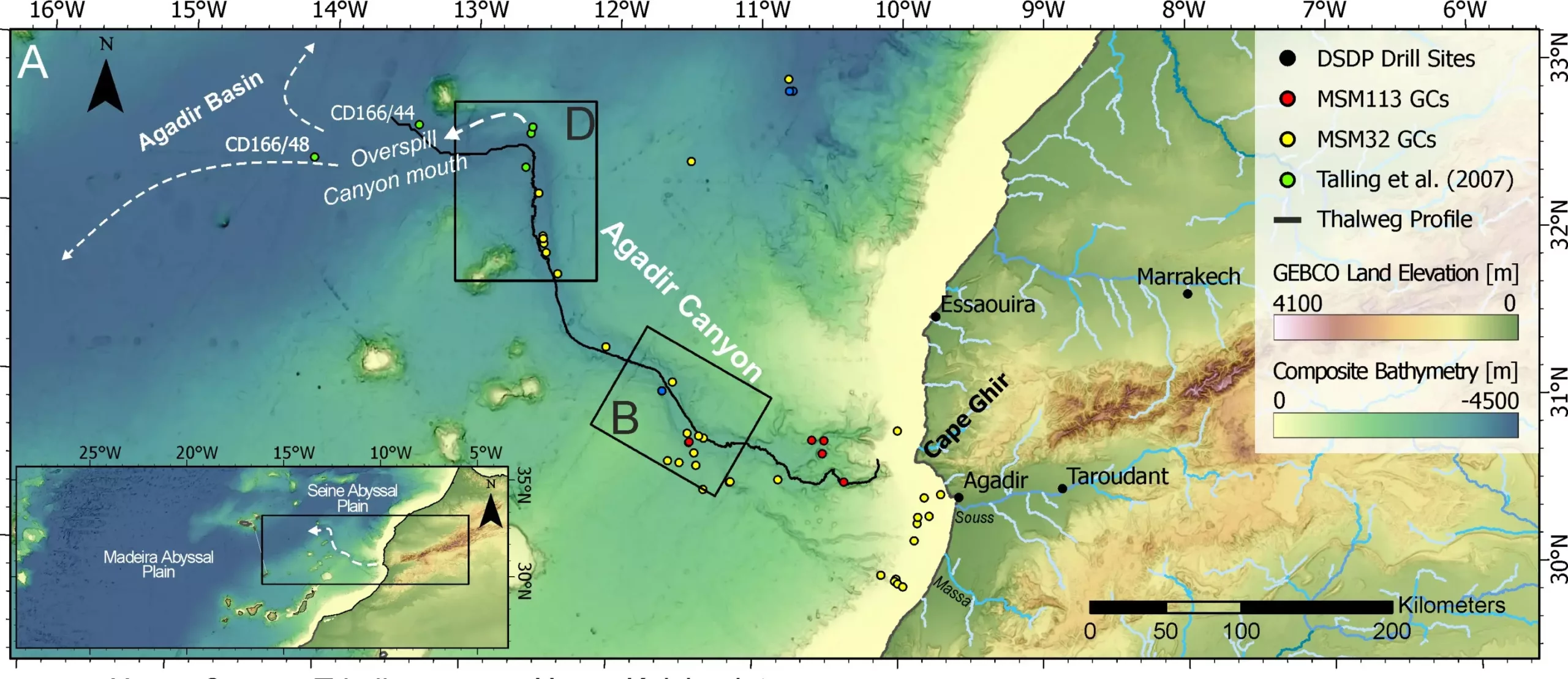Recent findings from researchers at the University of Liverpool shed light on a formidable yet unseen natural phenomenon—underwater avalanches. Unlike their terrestrial counterparts, these underwater cascades are challenging to detect and quantify, yet they can unleash catastrophic forces capable of reshaping oceanic landscapes. The study, entitled “Extreme erosion and bulking in a giant submarine gravity low,” published in *Science Advances*, unveils a particularly significant underwater avalanche that occurred nearly 60,000 years ago in the Agadir Canyon off the North West coast of Africa.
Dr. Chris Stevenson, a leading sedimentologist involved in the research, emphasizes the study’s novelty, proclaiming it the first detailed mapping of an entire underwater avalanche of this scale. The initial landslide measured approximately 1.5 km in volume but subsequently expanded over 100 times its original size as it traversed the seabed. This astounding growth is critical to understanding the mechanics and implications of underwater avalanches, as they can influence sediment dispersal patterns, ecological dynamics, and even human infrastructure on the ocean floor.
The research reveals that as this giant underwater avalanche moved through one of the world’s largest submarine canyons, it gathered a diverse range of materials—boulders, sand, gravel, and mud—into its ever-expanding mass. Spanning a distance of approximately 2,000 km, the avalanche not only displaced sediments but also eroded sedimentary structures, peeling away up to 400 km of the canyon’s length while pushing cobbles over 130 meters up its sides.
What is astonishing about these events is their sheer scale and speed. The Agadir Canyon avalanche reached elevations of about 200 meters and surged forward at an alarming rate of 15 m/s—akin to a high-speed train. To contextualize its size, envision a skyscraper plummeting through the ocean, creating a trench 30 meters deep and 15 kilometers wide, while simultaneously burying an area more extensive than the UK under a meter of various sediments.
Dr. Stevenson accentuates the unique behavior of underwater avalanches, stating that their capacity to grow disproportionately compared to other types of avalanches is noteworthy. While typical snow avalanches grow by four to eight times, underwater avalanches can increase by factors exceeding 100. This characteristic invites further scrutiny and research into their behaviors and potential variations across different submarine environments.
Understanding underwater avalanches possesses substantial implications for the infrastructure that exists on the ocean floor, such as the extensive undersea cables responsible for carrying vast amounts of global internet traffic. The growth and power of these underwater avalanches pose a significant geohazard, threatening the integrity of such infrastructure.
Professor Sebastian Krastel, the head of Marine Geophysics at Kiel University, reiterates the necessity of reassessing how such events are viewed. The earlier belief that substantial avalanches arise solely from pronounced slope failures has been fundamentally challenged. Presently, it is clear that minor landslides can escalate into massive and destructive geological events. This revelation compels scientists and engineers alike to reconsider how they assess geohazards, particularly in the context of safeguarding vital sea floor resources.
The research effort included collaboration from various institutions, including Kiel University and the Leibniz Institute for Baltic Sea Research. Over 300 core samples were rigorously evaluated alongside seismic data, enabling a comprehensible representation of the underwater avalanche. The extensive analysis utilized data collected over the last 40 years from seasonal research cruises, underscoring the importance of ongoing scientific exploration in underwater geoscience.
Moving forward, continued examination of these extreme geological events will be crucial. The researchers speculate that the behaviors observed in the Agadir Canyon may represent wider patterns in underwater avalanche dynamics that exist elsewhere. Future investigations will center around similar phenomena to further elucidate their mechanisms and impacts, thereby deepening our understanding of these unseen forces of nature.
The study of underwater avalanches exposes a hidden layer of Earth’s geological processes that carries significant weight—both literally and metaphorically. As the evidence mounts regarding the destructive capabilities of these phenomena, scientists are called to expand their research efforts in marine geoscience. Only by deepening our understanding of underwater avalanches can we adequately protect the fragile infrastructure resting on our ocean floors and appreciate the complexities of Earth’s ever-changing systems. The intriguing narratives of events like the Agadir Canyon avalanche will continue to pave the way for breakthroughs in this critical field of study.


Leave a Reply